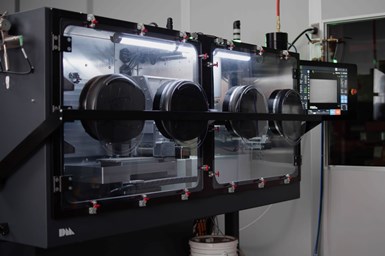Desktop Metal P-1 3D Printing System for End-Use Metal Parts
Rapid + TCT 2022: The P-1 shares the same Single Pass Jetting technology as the P-50, as well as common software and electronics for easy scalability.

Desktop Metal Production System P-1. Photo Credit: Desktop Metal
Desktop Metal’s Production System P-1 is a high-speed 3D printing system for end-use metal parts. It was designed as a gateway to the company’s top-of-the-line Production System P-50, which is the world’s fastest system to 3D print metal parts at scale, the company says.
The P-1 shares the same Single Pass Jetting (SPJ) technology as the P-50, as well as common software and electronics for easy scalability. This means full P-1 builds can be printed in less than one hour and process parameters can transfer directly to the P-50 for mass production jobs.
The company says the P-1 is now being used for a variety of development and serial production applications by a number of customers worldwide, including Ford Motor Co., Indo-MIM, Formula 3D Corp., Hong Kong Polytechnic University (PolyU), and Cetim - the Technical Center for Mechanical Industry in France.
The Production System is one of several Desktop Metal printing platforms that relies on binder jetting technology, which the company says is widely regarded as one of the 3D printing methods likely to deliver mass production additive manufacturing (AM) at high speeds and competitive prices.
Nearly a dozen metals are now qualified for printing on both systems which the company says deliver excellent part quality and surface finish, with sintered part mechanical properties that meet or exceed applicable industry standards, and final part densities up to or exceeding 99%. To date, the list of qualified materials includes stainless steels, including 17-4 PH, 316L, 420, 440C and DM HH SS; tool steels, including D2 and S7; low-alloy steels, including 4140; copper alloys; nickel superalloys, including IN625; and precious metals, including silver and gold. The company says Ti64 and 6061 is currently in development.
According to the company, this technology can help limit supply chain disruptions due to its ability to produce high-quality, cost-competitive end parts and tooling on demand for companies of all sizes, while delivering sustainability and innovation benefits.
Related Content
-
Carnegie Mellon Helps Industry, Students Prepare for a Manufacturing Future with AM and AI
Work underway at the university’s Next Manufacturing Center and Manufacturing Futures Institute is helping industrial additive manufacturers achieve success today, while applying artificial intelligence, surrogate modeling and more to solve the problems of the future.
-
Hybrid Additive Manufacturing Improves Debarking Knife Tip Strength and Production Efficiency
Nicholson Manufacturing chose the Mastercam APlus specialized add-on to unlock hybrid manufacturing for making its debarker knife tips, enabling it to add durable layers to the wear surfaces of the tips to make them more resilient while also making the production process more efficient.
-
7 Things We Saw at Formnext 2024 — Video Playlist
There were countless processes, applications and announcements at Formnext 2024. Here are seven standouts Peter Zelinski and Stephanie Hendrixson caught on film.














